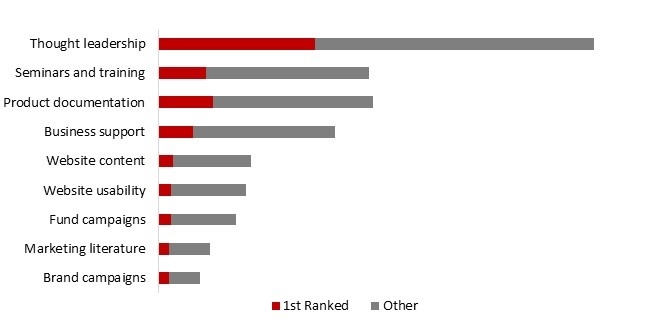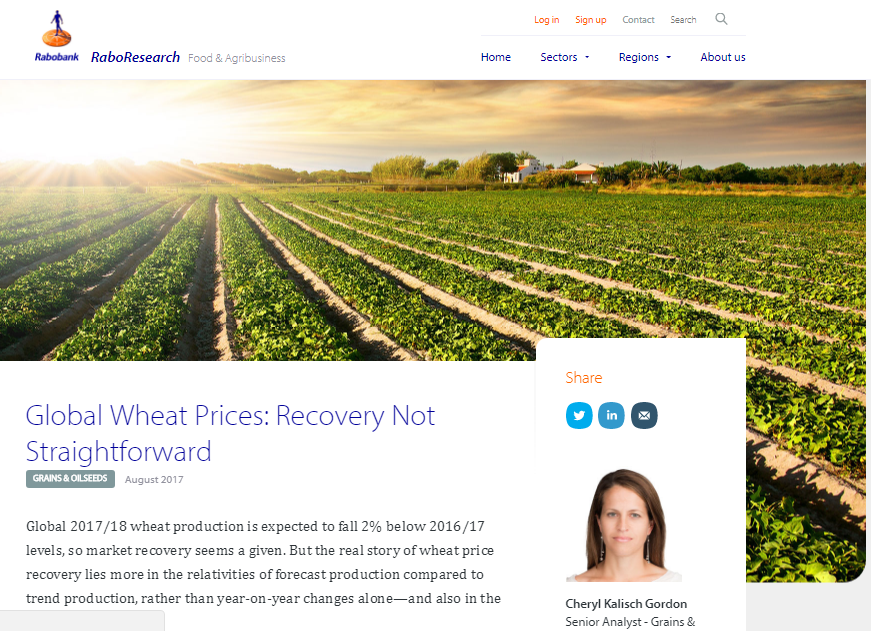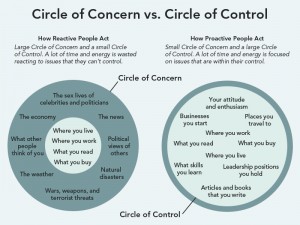— August 18, 2017
It’s no great mystery why thought leadership should be so enticing for asset managers.
In a sector riddled with regulation, where product differentiation often borders on the impossible, thought leadership provides a medium for clear, insightful, thought-provoking content that clearly distinguishes you and your company.
At least, that’s the idea.
In fact, “thought leadership” is among the most inescapable – and misused – buzzwords in the industry. Yet used well, it remains a particularly effective tool for marketing in asset management. But before we address why and how, it behoves us to ask:
What is thought leadership?
For all the term’s vagueness, thought leadership is, or at least should be, distinct from other forms of marketing content.
Mitch Fraser-Jones, head of investment communications at Woodford Investment Management, says, “Thought leadership is about providing content that makes people think about things in a new or different way.” The notion of challenging received wisdom is echoed by Anne-Marie McConnon, CMO international at BNY Mellon, who says, “Genuine thought leaders get noticed by offering some information, insights or ideas that are different.”
If we accept that influencing or challenging thought is the central tenet of “real” thought leadership, it becomes easier to distinguish it from other types of marketing content.
But is the distinction important?
In fact, terminology does matter. As we’ll see below, thought leadership in asset management can influence buyers’ decisions – for good and ill. If a company consistently produces “thought leadership” that is actually the most generic, inoffensive market analysis or white paper, cynicism toward the term, and toward the company itself, could grow. Conversely, thought leadership that regularly includes sharp, thought-provoking insights could serve to convey a company that is transparent, honest and does what it says.
(By all means, promote your other products and do market analysis. Just don’t call it “thought leadership”!)
So, if our basic definition of thought leadership is “content that challenges received wisdom, thereby provoking or leading thought”, we can work around some rules that make this more likely.
To provoke thought and challenge received wisdom…
Thought leadership shouldn’t:
- Just be news, regular market analysis or marketing spiel.
- Be explicitly self-promotional.
- Be reckless or pointlessly provocative or contrarian.
- Follow the herd.
Thought leadership should:
- Be original, with a clearly stated point of view.
- Be timely.
- Be credible, based on the asset manager’s expertise, specialties and extensive research.
- Be highly relevant, appealing and accessible to its intended audience.
- At least aspire to shift accepted wisdom on some level, and take the conversation in a new direction.
Why thought leadership matters
In a survey from last year, involving more than 1,600 interviews, NMG Consulting discovered that asset managers in institutional markets consider thought leadership to be the most valuable activity for promoting understanding and improving perceptions among clients.

More recently, LinkedIn and PR agency Edelman undertook a highly revealing joint study that canvassed the opinions of both content creators and decision-makers. Intriguingly, the study demonstrated that creators of thought leadership content greatly underestimate its impact on reputation and business generation.
Among its key findings:
- While just 17% of creators believed that thought leadership would lead to more RFP opportunities, fully 41% of C-suite executives said they had invited companies to submit proposals after having seen their thought leadership.
- Just 20% of creators credited their thought leadership with helping to close deals, while 45% of business decision-makers said it had made a difference.
- 59% of creators believed that thought leadership enhances their company’s credibility, compared with 88% of business decision-makers who said it does so.
- On a more chastening note, 35% of C-suite executives said that poor thought leadership had prompted them not to award business to the relevant company.
Clearly, if executed well, thought leadership can be hugely valuable to asset managers in driving business.
Which begs the question, just how is it done well?
Tips for getting it right
Be forthright…but not overly provocative or contrarian
Of all the elements of successful thought leadership, surely none is as important as a clearly defined point of view that challenges the status quo. While this may seem obvious, it’s striking how much “thought leadership” fails this basic test.
But for wealth managers who do this effectively, the impact can be profound.
In 2009, with global markets still reeling from the financial meltdown, many notable observers held – in line with economic orthodoxy – that the crisis could be paving the way for a new, long-term bull market in risk assets. Into this fray stepped PIMCO founder Bill Gross, with a keynote speech at the Morningstar Investment Conference. Citing new structural realities such as vast debt piles and lower global demand, Gross challenged the idea that better times were inevitably ahead. Low interest rates and low returns, he said, could be a “new normal”.
Although, in his implicit support for fixed-income markets, Gross could certainly be accused of being self-serving with this view, it was nothing if not bold, wide-ranging and credible. The fact that it was wrapped in an instantly memorable soundbite only added to its impact.
Now, there’s clearly a fine line between outspoken and overly provocative. In the wake of the UK’s momentous Brexit vote, some commentators may well have crossed it – not least this fellow, whose opinion can be divined from the headline “Brexit. Turkeys Voting For Christmas.”
The writer of this piece certainly doesn’t shirk from expressing an opinion. His arguments are forceful and lucid. But is his combative tone likely to win over many converts? More to our point, was a withering screed about Brexit’s economic failings really going against received wisdom in the asset management industry? The answer to both was very probably no.
Be timely, but don’t follow the herd
In making sense of the world, investors need to know about things that are important now. Brexit negotiations, central bank musings, election results – these are huge events that have enormous real-world financial consequences. But if reams of cookie-cutter fund manager analysis are rushed out in the hours following one of these momentous occasions, does it qualify as thought leadership? By definition, almost certainly not.
First of all, on a practical note, if you want to generate attention around your take on a big overnight event – an election, say – sending out your “thought leadership” sometime the following afternoon almost certainly isn’t going to cut it. Media outlets are desperate for expert opinion on such events, but only if they can get it quickly, early and/or first.
Of course, it’s not always possible to crank out insightful, long-form analysis in line with the news cycle. So for those times, to qualify as something that challenges or leads thought, a fresh outlook will be required.
That perspective could be historical, as was The Economist’s absorbing essay on “The slumps that shaped modern finance” – which was intended every bit as much as a lesson for regulators today as it was a dive into the history books. It could be somewhat contrarian, like “The truth about the Fed and inflation”, BlackRock’s response to the Fed’s rate rise in June. Or it could be educational, like MarketWatch’s “6 reasons to think twice before moving to Canada”, released just after Donald Trump’s victory in the US elections.
Again, not all of these options are going to be feasible – or desirable – for every asset manager. But the option of adopting an original perspective on current events always is.
Promote your view, not your product
You just know that your strategy and your team are best placed to deliver excellent risk-adjusted returns. What better way to convey this than in a stirring “thought leadership” piece about your segment of the market and why your fund is especially well-equipped to prosper in current conditions?
The problem, and an easily forgotten lesson in asset management, is that it is extremely difficult to maintain credibility while pushing your own product.
Thought leadership is not an exercise in altruism or academic navel-gazing. It is, at its core, marketing, and thus ultimately designed to sell you and your company. But if your aim is to “provoke or lead thought” and position yourself as someone whose expertise can deliver returns for your clients, what is more likely to achieve that? Thinly veiled shilling for a product? Or bold, impartial ideas that show genuine breadth of vision?
One leading asset manager that understands this is Aviva Investors, with its new AIQ magazine. Published in a modern, eye-catching format, and employing rigorous editorial standards, AIQ eschews product push, explicit or otherwise, in favour of expert long-form content produced by internal and external experts. The latest, tech-themed, issue includes features on AI and big data, along with analyses of the potential impact of an end to monetary easing.

Aviva Investors’ impressive new AIQ magazine – not a product push in sight.
While not everything in AIQ could lay claim to being thought leadership, the rejection of product push instils genuine credibility in the magazine’s opinion pieces. For readers, that nagging voice asking, “but what is this article selling?” can fall quiet, making them much more receptive to having their thoughts provoked or challenged.
Find your niche
Say M&G, and thoughts turn to Bond Vigilantes; Vanguard, and ETFs spring to mind.
For these reasons, when someone from the former talks fixed income, or a Vanguard manager discusses ETFs, markets listen.
Despite this, many asset managers attempt to cover all their bases with their thought leadership, a course of action almost certain to result in a vast expenditure of effort for minimal return. This certainly isn’t to say that asset managers shouldn’t market their lesser-known products. But if the intention is to produce memorable, insightful and impactful thought leadership, securing a niche is a massive step in the right direction.
Consider Rabobank. By retaining a central focus on the unsexy but indispensable sectors of food and agriculture, the bank has gained global renown as an expert in those fields, producing detailed, in-depth research that has made it a go-to source for agricultural expertise.

Rabobank – a leader in food and agricultural research.
For larger asset managers, a practical way to achieve this is finding specific sub-areas within asset classes – ideally aligning with the specific interests and knowledge of the fund managers – and focusing thought leadership efforts there. So if the broader goal is to be known for ESG, a good starting point is establishing expertise in, for instance, renewable energy or corporate governance structures.
If this niche credibility can be established and maintained – think Warren Buffett for buy-and-hold investing or Neil Woodford for UK income equities – it can, almost by definition, elevate much of what a manager says to the status of thought leadership.
Perfect the format
We’ve all heard the old philosophical conundrum of, if a tree falls when no one’s around, does it really make a noise? To this, we could add, if someone produces thought leadership, however brilliant, in a format that no one reads, is it really leading thought?
If, for instance, an asset manager wrote a study on how millennials can take their first steps into investment, but published it in a 20-page white paper in PDF format, such a glaring disconnect would immediately undermine any claims the writer had to understanding his audience.
And this certainly doesn’t only apply to millennials. Investment marketers churn out a blizzard of lengthy PDFs, text-heavy commentaries, and conventionally presented analysis to readers who won’t have anything like enough time (or inclination) to read it.
But for some financial services companies, this penny has definitely already dropped.
One success story in this area has been BNY Mellon Investment Management, which has transformed a rather staid, conventional marketing operation into a vibrant news-driven one. Lengthy reports have been broken down into bite-sized posts, and market analysis has been recast as an infographics blog.
Another formatting trailblazer is Morgan Stanley, which recently launched its Ideas podcast. Eschewing the well-trodden format of panel Q&As with industry experts, Morgan Stanley asks questions with broad appeal, in a professionally produced show, with guests from across the board. (The inaugural episode, Why Do Pro-Athletes Go Broke?, featured retired NBA star Antoine Walker.)

Morgan Stanley’s captivating new podcast series, Ideas.
Though not every infographic, video or podcast could lay claim to bringing about a major shift in the debate, presenting quality content in formats specifically designed for your target audience is a key component of establishing credibility as a thought leader.
The takeaway
If thought leadership were easy, everyone would be doing it (properly). Creating content that triggers real “aha!” moments in the minds of readers is undeniably tough, but the rewards, as the surveys above indicate, can be great.
If you provide:
- Forthright, fresh insights
- In a timely yet distinct manner
- While eschewing product push
- And occupying the right niche
- With the right format
Your thought leadership could be one of your most powerful sales tools.
Business & Finance Articles on Business 2 Community
(97)
Report Post





